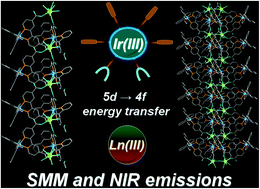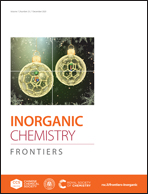Luminescent Ir(iii)–Ln(iii) coordination polymers showing slow magnetization relaxation†
Abstract
A series of iridium(III)–lanthanide(III) bimetallic coordination polymers were successfully obtained by hydrothermal reactions based on the Ir unit [Ir(ppy)2(Hdcbpy)], namely, [Ln{Ir(ppy)2(dcbpy)}2(NO3)(H2O)n]·solvent (Ir2Ln, n = 5, Ln = Gd and Dy; and n = 4, Ln = Er and Yb) and [Ln2(OH){Ir(ppy)2(dcbpy)}4(NO3)(H2O)4]·solvent (Ir4Ln2, Ln = Gd, Dy, Er, and Yb). Compounds Ir2Ln show chain structures in which the lanthanide ions are bridged by the Ir(ppy)2(dcbpy)− ligands through the carboxylate groups. Compounds Ir4Ln2 have double-chain structures, in which the dimers of Yb2(OH) are connected by the Ir(ppy)2(dcbpy)− ligands. Magnetic studies reveal that Ir2Dy and Ir4Dy2 exhibit slow magnetic relaxation behaviour in zero dc field, which is characteristic of single molecule magnets, but Ir2Er, Ir4Yb2, Ir4Er2 and Ir4Yb2 require a field to induce such characteristics. Moreover, since the iridium(III) moiety can serve as an “antenna” to effectively sensitize the f–f transitions of the lanthanide ions, near-infrared luminescence has been observed for the YbIII and ErIII complexes. As far as we know, this is the first observation of SMM behaviour and NIR luminescence in iridium(III)–lanthanide(III) bimetallic coordination polymers.

- This article is part of the themed collection: Rare Earth Chemistry – In memory of Professor Xu Guangxian at his centenary


 Please wait while we load your content...
Please wait while we load your content...